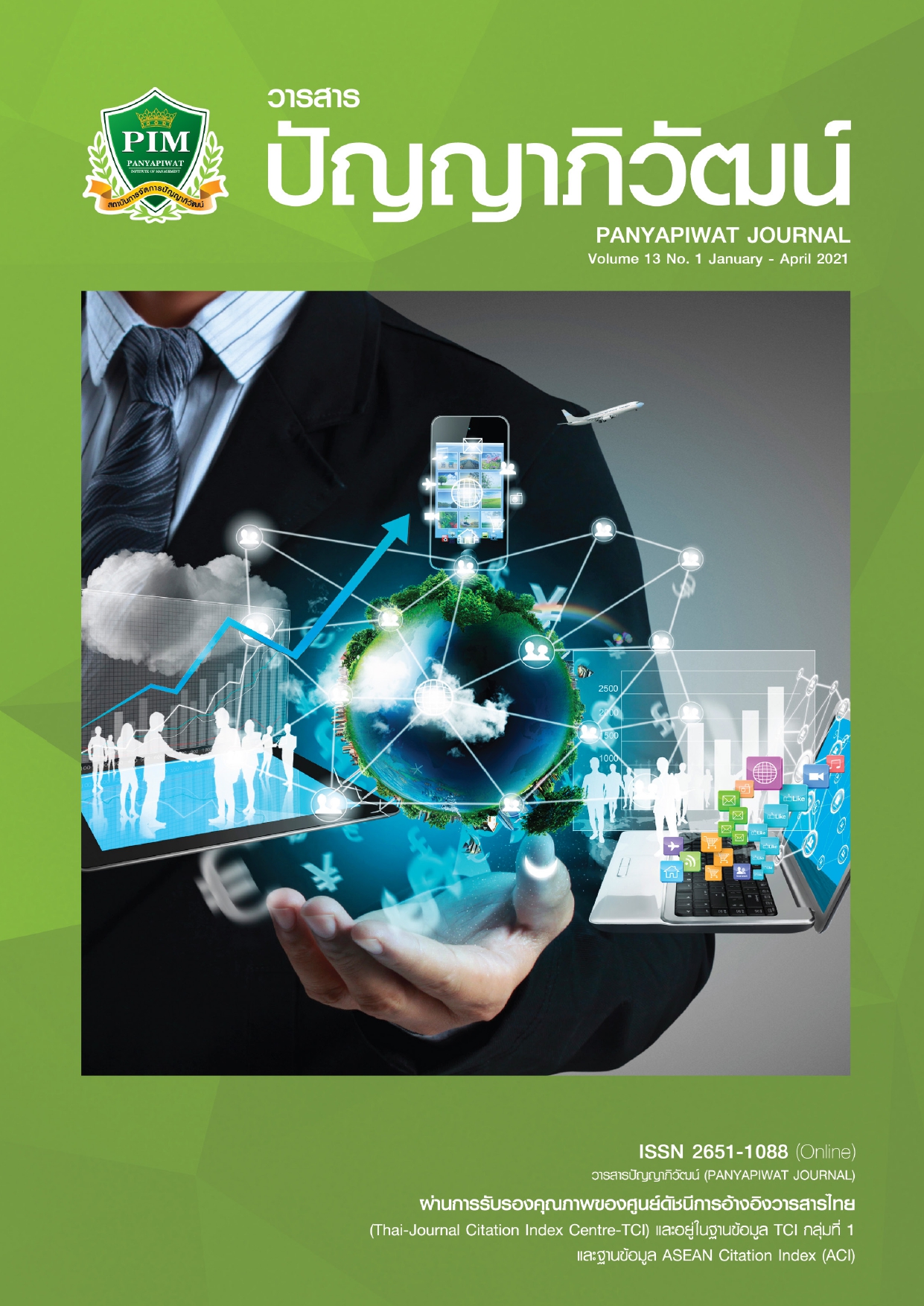สหสัมพันธ์คาโนนิคอลของปัจจัยการออกกำาลังกายนักศึกษา มหาวิทยาลัยเทคโนโลยีราชมงคลธัญบุร
Main Article Content
บทคัดย่อ
วัตถุประสงค์ของงานวิจัยนี้แบ่งตามลักษณะของลำดับขั้นตอนการวิจัยคือ การแสวงหาองค์ประกอบ ปัจจัยด้านแรงจูงใจและด้านเป้าหมายในการออกกำาลังกายของนักศึกษามหาวิทยาลัยเทคโนโลยีราชมงคลธัญบุรี ภาคการศึกษาที่ 2 ปีการศึกษา 2561 ตลอดจนวิเคราะห์สหสัมพันธ์คาโนนิคอลจากค่าสัมประสิทธิ์สหสัมพันธ์ระหว่างปัจจัยทั้งสองดังที่ได้กล่าวมาแล้ว โดยทำการศึกษาจากกลุ่มตัวอย่างนักศึกษามหาวิทยาลัยแห่งหนึ่ง จำนวน 340 คน ด้วยการสุ่มอย่างง่าย จากนั้นจึงได้ทำาการวิเคราะห์สหสัมพันธ์ของเพียร์สัน และนำาไปวิเคราะห์องค์ประกอบตลอดจนสหสัมพันธ์คาโนนิคอลในลำาดับสุดท้าย งานวิจัยนี้เป็นใช้วิธีวิจัยเชิงปริมาณ โดยมีแบบสอบถามเป็นเครื่องมือในงานวิจัย ทดสอบความเชื่อมั่นโดยวัดความสอดคล้องภายในจากวิธีคำนวณค่าสัมประสิทธิ์แอลฟาของครอนบาค มีค่าเท่ากับ .893 ผลการวิจัยพบว่า แรงจูงใจมีความสัมพันธ์กับเป้าหมายในการออกกำลังกายเป็นไปดังสมมติฐานที่ตั้งไว้ ความสัมพันธ์กับเป้าหมายในการออกกำลังกายนั้นน้ำหนักกับแรงจูงใจภายในมีในการออกกำลังกายมากกว่าแรงจูงใจภายนอก สรุปได้ว่าการตัดสินใจของวัยรุ่นที่เกิดจากภายใน อาจจะมีอิทธิพลต่อการออกกำลังกายมากกว่าการตัดสินใจจากภายนอกซึ่งเป็นไปตามทฤษฎีการกำหนดตนเอง (Self-Determination)
Article Details
“ข้าพเจ้าและผู้เขียนร่วม (ถ้ามี) ขอรับรองว่า บทความที่เสนอมานี้ยังไม่เคยได้รับการตีพิมพ์และไม่ได้อยู่ระหว่างกระบวนการพิจารณาลงตีพิมพ์ในวารสารหรือแหล่งเผยแพร่อื่นใด ข้าพเจ้าและผู้เขียนร่วมยอมรับหลักเกณฑ์การพิจารณาต้นฉบับ ทั้งยินยอมให้กองบรรณาธิการมีสิทธิ์พิจารณาและตรวจแก้ต้นฉบับได้ตามที่เห็นสมควร พร้อมนี้ขอมอบลิขสิทธิ์บทความที่ได้รับการตีพิมพ์ให้แก่สถาบันการจัดการปัญญาภิวัฒน์หากมีการฟ้องร้องเรื่องการละเมิดลิขสิทธิ์เกี่ยวกับภาพ กราฟ ข้อความส่วนใดส่วนหนึ่งและ/หรือข้อคิดเห็นที่ปรากฏในบทความข้าพเจ้าและผู้เขียนร่วมยินยอมรับผิดชอบแต่เพียงฝ่ายเดียว”
เอกสารอ้างอิง
Abhiwong, C. (2011). Exercise Bahavior of Students at University of the Thai Chamber of Commerce. Master’s degree study thesis, University of Thai Chamber of Commerce. [in Thai]
Anothai, A., Piaywan, S., Orapan, K., Kanokpan, S., Rohaya, M., Wilaipan, B., & Maneerat. (2018). Factor Related to Exercise Behavior of Physical Therapy Students in Huachiew Chalerm prakiet University. HCU Journal of Health and Science, 21(42), 55-64. [in Thai]
Barcikowski, R. S. & Stevens, J. P. (1975). A Monte Carlo Study of the Stability of Canonical Correlations, Canonical Weights and Canonical Variate-variable Correlations. Multivariate Behavioral Research, 10(3), 353-364.
Boonmee, W. (2013). Canonical Correlation of Supervision Factors on School Administration. Doctoral Dissertation, Department of Educational Administration, Silpakorn University. [in Thai]
Deci, E. L. & Ryan, R. M. (1975). Intrinsic Motivation. New York: Plenum Press.
Edmunds, J., Ntoumanis, N., & Duda, J. L. (2006). A Test of Self-Determination Theory in the Exercise Domain. Journal of Applied Social Psychology, 36(9), 2240-2265.
Feito, Y., Brown, C., Box, A., Heinrich, K. M., & Petruzzello, S. J. (2018). An Investigation Into How Motivational Factors Differed Among Individuals Engaging in CrossFit Training. SAGE Open, July-September, 1-8.
Jaisamut, S. (2011). Motivation to exercise of Satun citizen in 2010. Master’s degree study thesis. Department of Physical Education, Srinakharinwirot University. [in Thai]
Kongcheewasakul, C., Klanarong, S., & Sathirapanya, C. (2014). Exercise Behaviorfor Health of RajamangalaSrivijaya University Students, Songkhla CampusSorat. Al-Nur Journal of Graduate School of Fatoni University, 9(16), 59-70. [in Thai]
Magaraggia, C., Dimmock, J., & Jackson, B. (2014). Motivational Priming as a Strategy for Maximising Exercise Outcomes: Effects on Exercise Goals and Engagement. Journal of Sports Sciences, 32(9), 826-835.
Maslow, A. H. (1943). A Theory of Human Motivation. Psychological Review, 50, 370-396.
Pasunon, P. (2010). Business Statistics. Bangkok: Academic Resource Center Thai-Japanese Institute of Technology. [in Thai]
Ryan, R. M. & Deci, E. L. (2000). Self-determination Theory and the Facilitation of Intrinsic Motivation, Social Development, and Well-being. American Psychologist, 55(1), 68-78.
Saengdao, T. (2012). Motivation for Exercise of Members Using the Fitness Hatch Fitness Center in Nonthaburi Province, 2010. Master’s degree study thesis, Department of Physical Education, Srinakharinwirot University. [in Thai]
Sebire, S., Standage, M., & Vansteenkiste, M. (2008). Development and Validation of the Goal Content for Exercise Questionnaire. Journal of Sport & Exercise Psychology, 30, 353-77.
Snyder, K., Lee, J. M., Bjornsen, A., & Dinkel, D. (2017). What Gets Them Moving? College Students’ Motivation for Exercise: An Exploratory Study. Recreational Sports Journal, 41, 111-124.
Srisa-Ard, B. (2002). Introduction to statistics (7th ed.). Bangkok: Suweeriyasarn. [in Thai]
Sutthilertaroon, S. (1985). Educational Psychology (2nd ed.). Bangkok: Graduate letters. [in Thai]
Tangthai, T. & Dadee, A. (2009). Dhurakij Pundit University Staffs and Students’ Behavior and Demand for Need of Exercise. (Research Report). Bangkok: Dhurakij Pundit University. [in Thai]
Teixeira, P. J., Carraça, E. V., Markland, D., Silva, M., & Ryan, R. (2012). Exercise, Physical Activity, and Self-determination Theory: A Systematic Review. International Journal of Behavioral Nutrition and Physical Activity, 9(1), 1-30.
The Ministry of Tourism and Sports Thailand. (2017). The Sixth National Sports Development Plan (2017-2021). Bangkok: Office of Permanent Secretary Ministry of Tourism and Sports. [in Thai]
Thiamklang, R., Aphanphansiri, M. D., & Wongchaturaphat, N. (2016). The Hierarchy of Needs Affecting Exercise Motivation of Fitness Club Members. Bangkok: Srinakharinwirot University. [in Thai]
Wanichbancha, K. (2006). Advanced Statistical Analysis with SPSS (5th ed.). Bangkok: Thammasarn Company Limited. [in Thai]
Weiss, M. R. & Amorose, A. J. (2008). Motivational Orientations and Sport Behavior. In T. S. Horn (Ed.), Advances in Sport Psychology (pp. 115-155, 437-444). New Milford, USA: Human Kinetics.
Yamane, T. (1967). Statistics: An Introductory Analysis (2nd ed.). New York: Harper and Row.
Yeammit, C. (2013). Exercise Behavior of Non Formal Education Center Student in Krabi Area in Academic Year 2008. Master Thesis Graduate School, Srinakharinwirot University. [in Thai]


